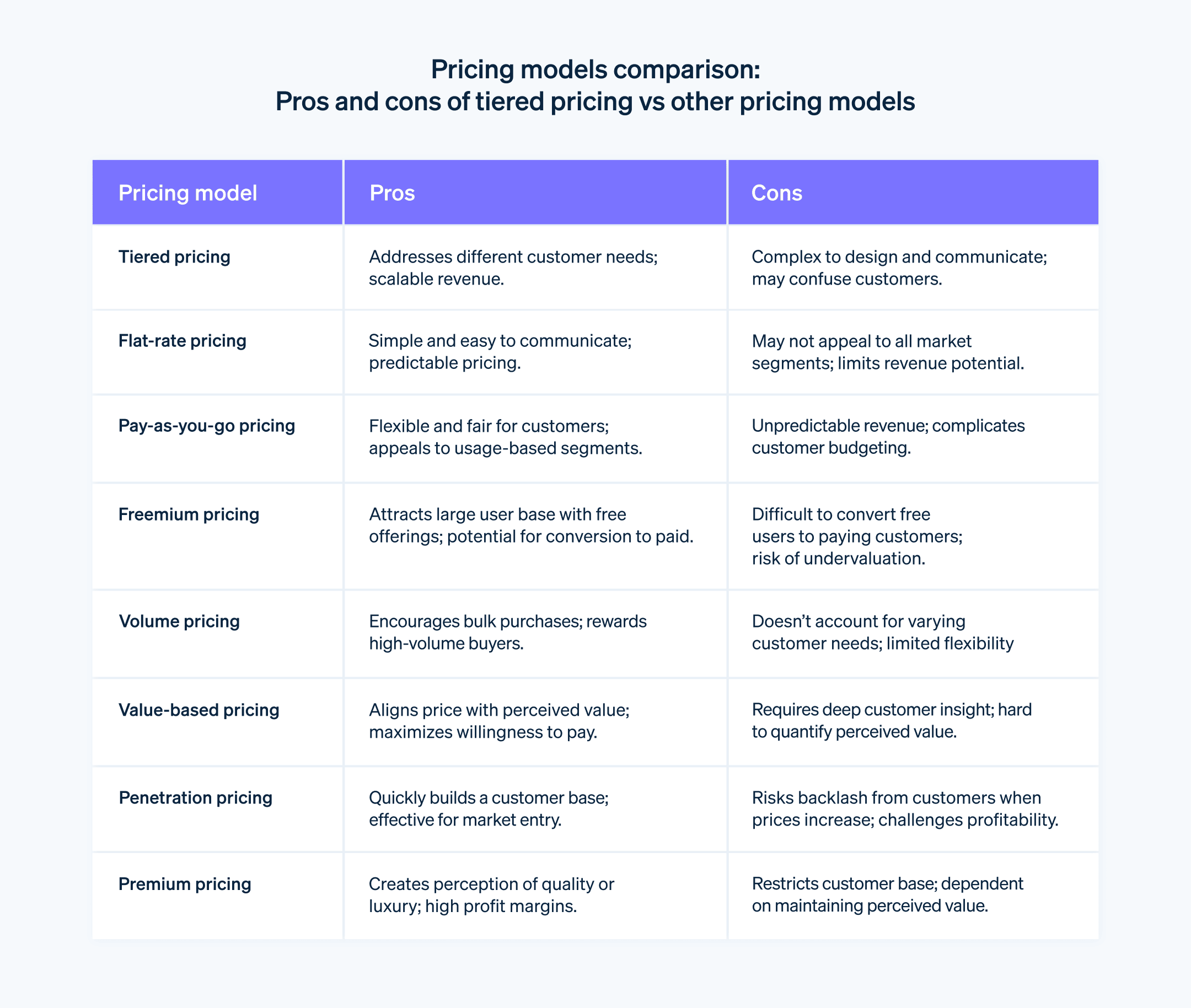分层定价是企业用来根据客户购买的不同级别或数量设定产品或服务成本的一种策略。客户购买量越大,他们为每件商品支付的费用就越少。这种结构在各行各业都很常见,是企业奖励客户进行大额购买的一种方式。
一些过去可能没有考虑过差异化定价的企业现在正在利用这种模式来实现收入增长和客户参与度。其吸引力是显而易见的:分层定价结构使企业能够满足广泛的客户群,以不同的价位提供不同层次的价值和服务。正如哈佛商业评论所指出的那样,此类层级通常是 Good-Better-Best(即 G-B-B)定价的一个例子,这是一种考虑定价层级的简单方法。这种策略最大限度地扩大了市场覆盖率,也迎合了客户的支付意愿,从而可以增加整体销量。
分层定价模式为企业提供了稳定性。通过为客户提供选项,企业可以将单次购买客户转化为不同层级的回头客。这种多样性有助于更精确的财务预测,并能改善资源分配。分层定价的多个切入点使客户能够扩展对品牌产品或服务的承诺,从而使客户在需求增长时升级到更高的层级。
分层定价主要使企业受益。分层定价的挑战在于其执行:确定定价结构涉及许多利益相关者。这个过程需要分析产品或服务,并了解客户群和市场的具体需求。下面,我们将介绍企业应该了解的分层定价模型,包括哪些企业可以最有效地使用它们,以及如何选择正确的模型来满足业务目标和市场需求。
目录
- 分层定价如何运作?
- 如何为您的业务计算分层定价?
- 使用分层定价的好处
- 使用分层定价面临的挑战
- 分层定价与其他定价模型的对比
- 如何通过分层定价实现利润率最大化
- 分层定价最佳实践
分层定价如何运作?
通过分层定价,企业将以一定的费率为产品的第一层设定价格。随着客户购买量的增大,他们开始适用下一层级,在该层级上的单位价格更低。例如,如果客户要购买软件许可证,则前 10 个许可证的价格可能为 100 美元,但如果购买 20 个许可证,则所有许可证的价格可能为每个 90 美元。
每个定价层级代表一个阶梯。随着客户在阶梯上向上移动,总售价会随着产品数量或买方享受优惠的增加而增大。例如,软件公司可能会在最低层级提供具有标准功能的基本软件包。下一层级可能包括更高级的功能和更高的使用限值,总价更高。顶层可能包括所有可能的功能、最高使用限值和高级支持服务。
如何为您的业务计算分层定价?
为您的业务计算分层定价是一个战略过程,在这个过程中,您需要将产品或服务与不同客户群的支付意愿相匹配,同时覆盖成本并实现所需的利润率。由于这可能是一项复杂的工作,许多企业将特定资源投入于此项目:在接受安永 2023 年软件定价调查的高管受访者中,63% 的高管有专门的定价团队。下面介绍制定定价层的工作原理:
完成成本分析
首先分析生产产品或服务所涉及的成本。这个数字应包括材料和人工等直接成本以及间接成本(如管理开销)。找到您可以收取的能覆盖成本的最低价格。进行市场调查
进行市场调查,以了解客户的价格敏感度和竞争对手的定价策略。这将帮助您确定市场的现实定价水平。定义客户细分
确定可能具有不同需求和支付意愿的客户细分。最终,您将针对特定细分市场设置每个定价层,从对价格最敏感的细分市场到寻求高级选项的细分市场。确定价值主张
对于每个客户细分,定义价值主张。每个层级的客户最看重什么?可能的选项包括更多功能、更多数量或更好的服务。这将帮助您设计客户认为物有所值的层级。设置定价层
确定层数并设置每个层的价格,以便每个层之间的价值有明显的差异。最低层应涵盖生产基本产品或服务的所有成本,而较高层应根据附加值和服务成本提高价格。为各层分配功能或数量
将功能、数量或服务分配给每个层。较低层可能具有基本功能或数量有限,而较高层可能包括附加功能、更多数量或增强服务。实施成本效益分析
对每一层执行成本效益分析。确保在每一层提供产品或服务的成本低于您计划收取的价格。审查和调整
查看分层定价模型,确保其合理,并且收益随价格而适当增加。根据反馈和进一步分析进行必要的调整。传达价值
向客户传达每一层的价值。客户应该清楚他们因支付更多费用而获得的价值。监控和优化
实施后,监控每个层的业绩。客户是否在更高层级中发现了价值?大多数客户是否选择价格最低的选项?使用此数据来优化您的层级和定价。
在整个过程中,将客户对价值的感知放在首位。目标是提供客户认为公平且符合他们所获价值的选项,这反过来又可以支持为企业实现强大的收入流。
使用分层定价的好处
分层定价在短期和长期内都能为企业带来多项优势。以下是此模型的最大优点:
市场渗透率
您可以通过入门级定价吸引更广泛的客户群,同时还可以满足那些寻求高级选项的客户群。这种灵活性意味着您不会放弃愿意为额外功能或服务支付更多费用的客户。客户增长
分层定价可促进客户帮助您实现业绩增长。客户可能从基本层开始,但随着需求的增长,他们可能会在层级中向上移动。这种自然的升级可以增加收入,而无需不断获得新客户。包容性
分层定价可以营造一种包容性,因为它可以在不排除潜在客户的情况下适应不同的预算水平。每个潜在客户都可以找到适合自己预算的层级,这可以扩大您的市场范围。决策简单
定价层简化了客户的购买决策。清晰的选项使客户更容易比较功能并决定哪个层级最适合他们,从而减轻决策负担并可能缩短销售周期。可扩展性
分层定价为扩展提供了一个简单的结构。随着需求的增长或产品的开发,您可以按照基于现有结构的基本原理添加新层或调整现有层。适当的期望
通过定价层,可以将客户期望与服务级别相匹配。客户看到,支付更多费用能得到更好的服务或更多功能,这有助于提高其整体满意度。品牌认知度
高端定价层可以将您的品牌与优质产品和服务相关联,从而提升您的品牌地位(即使您的大多数客户选择较低层)。竞争策略
通过多个价位,您可以同时在价格和价值上展开竞争,有可能超越仅以单一价位运营的竞争对手。客户洞察
通过分层定价,您可以收集有关客户偏好和价格敏感度的宝贵数据。您可以跟踪哪些层级最受欢迎,并相应地调整您的产品开发和营销策略。
使用分层定价面临的挑战
分层定价有其自身带来的一系列挑战。这些包括:
管理复杂
管理多个定价层会给业务运营增加障碍。企业必须跟踪不同的服务级别、客户权利和计费安排,这可能会给管理资源带来压力。客户困惑
过多的选项或定义不明确的层级可能会使客户不知所措,导致决策艰难。如果客户无法轻松确定层级之间的差异或看到较高价格层的价值,他们可能会选择最低层级,从而降低您的收入。自相残杀
如果您的分层定价模型设计得不够合理,则低价层可能会蚕食高价层的销售额。如果客户认为较低层为他们的需求提供了更好的价值,则他们可能会降级,从而影响您的整体盈利能力。收入预测
预测收入在分层定价中可能更具挑战性,尤其是当您的预测依赖于客户升级到更高层级时。关于有多少客户会在定价阶梯中上升,以及这种情况发生的速度有多快,总会存在一些不确定性。定价平衡
为每一层的定价找到合适的平衡点可能很棘手。价格定得太低,可能赚不到什么钱;定得太高,则可能会吓跑潜在客户。价值感知
您必须不断证明更高层级的价值。如果客户认为这些好处不值得额外的成本,就不会升级,这可能会降低分层定价模型的有效性。品牌风险
如果高层级定价过高,可能会损害您的品牌声誉。客户可能会认为您的业务定价过高或与他们的需求脱节,从而导致失去客户信任,进而可能失去市场份额。市场契合度
并非所有产品或服务都适合分层定价模型。该模型最适合具有差异化的产品,并且市场表现出一系列需求和预算。调整面临的挑战
一旦客户习惯了特定的定价层,他们一般不愿意做出改变。如果您决定调整功能或价格,则可能会扰乱您的客户群。
要应对上述任一挑战,都需要深思熟虑和持续管理,以确保分层定价达到预期目的,从而促进业务增长和客户满意度。
分层定价与其他定价模型的对比
作为一种策略,分层定价具有区别于其他定价模型的特征。但这远不是为您的业务创建定价模型的唯一方法。以下是一些替代方案:
统一费率定价
与分层定价不同,统一费率定价对产品或服务收取单一价格,而不考虑具体使用情况或客户类型。这种模式简单明了,易于与客户沟通,但它可能不会吸引所有细分市场,并且可能会降低潜在收入。即用即付定价
此模型根据客户的使用情况向客户收费。虽然从客户的角度来看,它灵活且公平,但它可能会使企业的收入变得不可预测,并使客户的预算复杂化。免费增值定价
使用免费增值定价,产品或服务的基本版本是免费的,而高级功能需要付费。其挑战在于将免费用户转化为付费客户,这些高级功能必须足以吸引人以证明成本的合理性。批量定价
批量定价涉及基于购买数量给予折扣。它可以有效地鼓励更大的购买量,但并未像分层定价那样考虑客户群的不同需求。基于价值的定价
该模型根据对客户的感知价值(而不是产品的成本或市场价格)来设定价格。它需要对客户有深入的了解,并且很难量化,但其优点是使价格与客户赋予产品的价值相匹配。渗透定价
企业设定低价进入市场,并在站稳脚跟后提高价格。这可以快速建立客户群,但如果客户抵制价格上涨,就会面临长期无法盈利的风险。溢价定价
与渗透定价相反,溢价定价将价格定得很高,以创造高质量或奢华的感觉。这可能会限制客户群,但它可以从每笔销售中产生高利润。

如何通过分层定价实现利润最大化
通过分层定价实现利润最大化意味着找到最佳点:既可以为客户提供最大价值,同时仍能获得可观的回报。以下是一些利润率最大化方法:
精确地设置层级
价值主张逐层递进。当客户在这些层级中提升时,他们应该觉得每上升一层,交易都更划算。企业必须在较低层级提供足够的价值来吸引客户,同时让想要更多价格的客户无法抗拒较高层级。成本结构剖析
准确了解您的企业提供每一层级的成本。您的最低价格应该稍微超出覆盖成本,从而为更高层级的产品带来最大收入奠定基础。心理定价技巧
使您的层级定价略低于常见阈值(例如收取 9.99 美元而不是 10 美元)可能会影响客户对价值的看法。首先将您的客户锚定为最高层。相比之下,这使得其他层级的价格似乎更合理。数据驱动的决策
监控哪些层级最受客户欢迎并随时进行调整,以利用数据的力量。也许在更高层级中有一个受欢迎的功能,您可以利用它来鼓励升级。或者削减某个用过的低层功能以降低成本。鼓励升级的激励措施
通过适当的激励措施吸引客户升级。这可能是更高层级第一个月享受折扣,或者客户只能通过高级选项访问独家内容或服务。使层级之间的过渡平稳且有吸引力。反馈环和适应性
建立反馈环并倾听客户的意见。如果大家都想要某个功能,而您尚未提供,请考虑将其添加到更高层级。保持适应性,并愿意对您的产品或服务进行更改。以客户终身价值为中心
密切关注客户终身价值。吸引较低层级的客户固然很好,但最大的胜利是让他们使用并喜欢这项服务时决定升级。这是您长期盈利能力的来源。沟通清晰
客户应该确切地知道他们在每一层级能得到什么,并了解为什么下一层级值得额外付费。客户应该始终轻松知道他们能获得的价值。竞争分析
密切关注竞争。如果竞争对手在较低层级提供更多价值,您需要做出回应。如果他们的层级定价过高,请借此机会以更优惠的价格吸引客户。动态定价注意事项
在适当的情况下考虑动态定价策略。也许在高峰期您可以收取额外费用,或者在特殊活动中,更高层级的促销价格是有意义的。
使用分层定价来最大化利润率是一个综合考量,您不仅要考虑战略定位、客户心理以及不断微调产品以满足客户需求,还要考虑提高利润。
分层定价最佳实践
创建和管理分层定价计划需要将战略规划和持续管理相结合,以确保您的业务随着时间的推移保持相关性和盈利能力。以下是制定分层计划的最佳实践:
进行市场调查
了解您的受众。他们是谁,他们需要什么?他们愿意支付多少钱来获得所需的价值?了解上述信息是创建与您的市场产生共鸣的层级的关键。完成成本分析
了解您的成本结构和具体数字。计算出交付每个层级的成本,并设置定价,使其不仅涵盖这些成本,而且有助于提高您的利润率。进行竞争分析
参考竞争对手的定价模式。它们可以提供对市场标准的宝贵见解,并帮助您定位您的层级。提供明确的价值主张
向客户清晰展示他们选择任何给定层级的理由。应根据功能、服务或其他优势来合理定价。提供可调整的功能
设计各个层级,以便您可以轻松地调整,根据客户反馈或市场趋势增加或减少服务。显示简单的选项
有所选择挺不错,但选择太多会让人不知所措。保持层数可管理,以便客户轻松选择适合他们的层数。保持结构的灵活性
当您详细了解客户最看重的价值时,请准备好调整您的层级。
以下是管理持续分层计划的最佳实践:
关注客户行为
注意客户如何与您的层级互动。哪些层级最受欢迎?客户是升级还是降级?定期审查成本和利润
定期重新评估您的成本和利润率,以确保每一层级都能在成本和市场条件发生变化时保持盈利。根据反馈进行调整
利用客户反馈来完善您的产品。如果某些功能需求量很大,请考虑将它们添加到更高的层级。激励升级
偶尔的促销活动可以鼓励客户迁移到更高层级。传达变更
确保提前将分层计划的任何变更传达给客户。使用数据分析
使用数据分析来了解使用模式和客户偏好,从而为有关定价和功能的战略决策提供信息。执行 A/B 测试
测试不同的定价结构和功能,看看什么能引起受众的共鸣,并带来更高的留存率和升级率。提供客户支持
在所有层级都提供出色的客户支持,但请考虑为更高层级的客户提供高级支持选项。
详细了解 Stripe 如何支持分层定价模型。
本文中的内容仅供一般信息和教育目的,不应被解释为法律或税务建议。Stripe 不保证或担保文章中信息的准确性、完整性、充分性或时效性。您应该寻求在您的司法管辖区获得执业许可的合格律师或会计师的建议,以就您的特定情况提供建议。